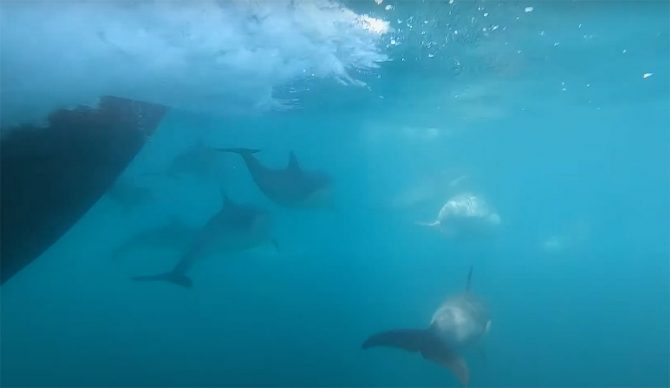
Fun and quick. That’s the name of the transportation game when it comes to dolphins. Photo: YouTube//Screenshot
We’ve all seen bow-riding dolphins. It seems clear to anyone looking that they’re doing it for fun, but it’s very easy to anthropomorphize animals of all kinds. Without speaking to a dolphin directly, it’s pretty difficult to know for certain if they are indeed simply playing, but a group of researchers recently attempted to do just that.
The study, called “Energetic Savings of Bow-Riding Dolphins“, was recently published in the esteemed journal Nature. As the title suggests, the researchers were looking for just how much energy a dolphin saves by cruising along ahead of a boat. It turned out that, along with that, they have the added benefit of having an absolute blast.
“If you think about someone surfing, for example, why do people surf? Because it’s fun,” co-author Dr. Dara Orbach, Assistant Professor of Biology at Texas A&M University-Corpus Christi, told IFLScience. “They also are getting energy while they’re actually on the board. Just because they’re getting a transportation benefit doesn’t exclude that there’s another purpose there as well.”
In short, just because something is useful doesn’t mean it isn’t also enjoyable. A motorcycle, for example, is a useful way of getting from point A to point B, but — depending on your personal tastes, anyway — it’s also about the most fun way of doing it.
The researchers studied dusky dolphins off the shores of New Zealand. Using drones to collect as much footage of bow-riding dolphins as possible, they were able to watch exactly what they were doing.
“This was not easy to do,” study co-author Dr. Lorenzo Fiori, also from Texas A&M University-Corpus Christi, told IFLScience. “These animals are very fast, and we needed to fly at a lower altitude looking straight down, meaning our field of view as drone pilots is quite limited. It’s almost like you are a bird of prey.”
Good science often requires long, arduous data collection, and this study was no different. Using the footage they collected in slow-motion, the researchers were able to count each time the dolphins’ blowholes opened. That let them know the respiration rate, which, just like a human running, changes depending on the body’s output.
As a dolphin works harder, they breathe harder. But while bow-riding, their respiration rate dropped dramatically.
Obviously, different vessels put up larger waves, so the dolphins used them differently. Using those differences gives scientists more insight into the behaviors of dolphins, which is important for us to help them survive in a world that’s increasingly hostile to their way of life. With more knowledge, we can better understand what we need to do to keep them and their ecosystems healthy, which is good for us in turn.
“Dolphins are really important bioindicators of their environment,” Orbach explained, “so they’re important for telling us more about the health of an ecosystem, and, in general, they have an intrinsic value in terms of their role in the food chain.”
One takeaway was that simply slowing down in areas where there are lots of dolphins could help save them from boat-strikes. In other areas where dolphin populations are lower, higher speeds are fine.
The study does appear to offer the most convincing proof yet that dolphins are not only using bow waves to get around easier, but to ride waves simply for sake of riding waves.

